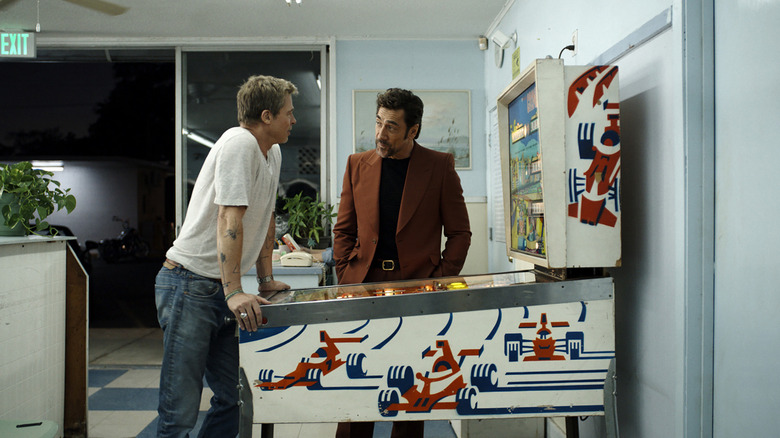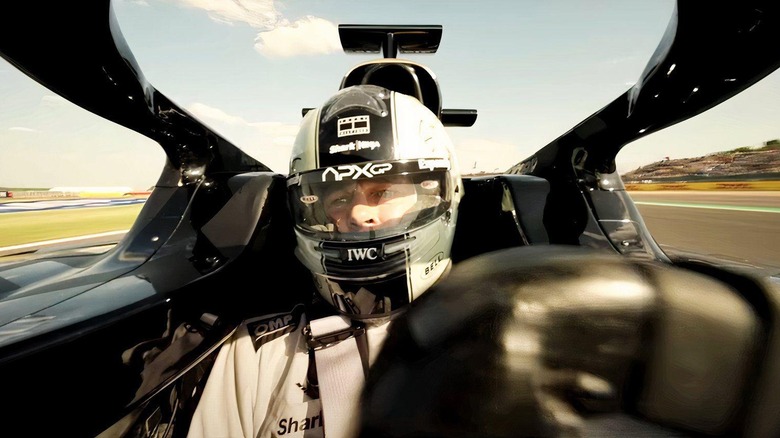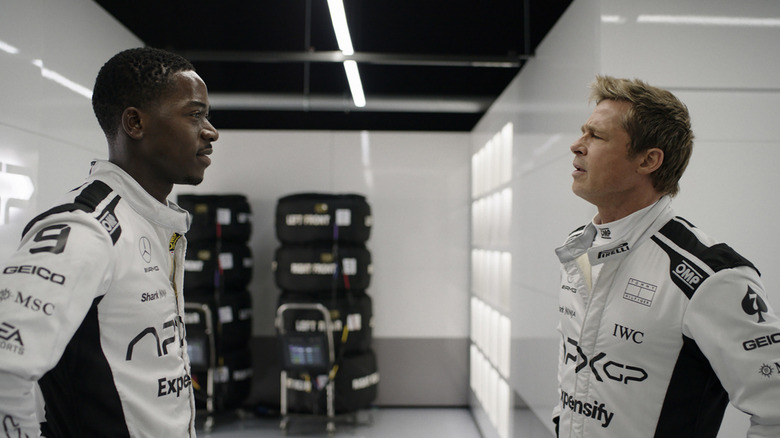Brad Pitt's F1 Does For Driving What Top: Gun Maverick Did For Flying
Movies about sports can be truly special, but there is no sport quite like racing, particularly Formula One. The combination of athleticism in the drivers, the science and engineering of the cars, and the chess-like strategy of the different teams using positioning, vehicle choices, and team play to win titles makes this a sport like no other. It also means the best movies about racing are inherently thrilling since it's a world very few ever get to see from up close.
The best racing movies are those that offer unparalleled immersion, placing the audience in the driver's seat. There have been plenty of these before but few quite like Joseph Kosinski's "F1," a movie that admittedly has a bloated storyline that's overly reminiscent of "Top Gun: Maverick" yet also boasts some of the most exciting racing scenes ever filmed. Indeed, there are multiple similarities between the two films besides the fact that Kosinski directed both of them — not the least of which is they each follow an aging white guy who is confronted with a world that is leaving them behind, offered one last chance at glory, and becomes the hero of the story on the shoulders of a young generation.
But most of all, it's the way "F1" immerses viewers in its world that makes it work (much like "Maverick" did). Not only that, but it also does this in a fashion that we haven't seen in a long time when it comes to racing movies.
F1 is an impressive achievement in cinematography
There have been car racing movies for decades, but for the most part, modern ones tend to be period movies about important events in the history of the sport, like "Ford v Ferrari" or "Rush." The major exception is John Frankenheimer's 1966 masterpiece "Grand Prix." That movie was an achievement in cinematography, inventing new rigs, camera lenses, and techniques in order to bring audiences into the driver's seat in a way no film before (and few since) had done. It even put real actors in real racing cars to better capture the look and feel of Formula One.
Now, Kosinski is following in those footsteps by taking what he did in the air with "Top Gun: Maverick" and applying it to the ground. His spirit of doing things for real results in some truly stunning camerawork and incredible stunts. That's because, just like the cast of "Top Gun: Maverick" filmed in real jets, so too did Brad Pitt hop into a real racing car for this movie.
Speaking with GQ, Kosinski defended this choice, saying audiences feel it in their gut "when they're watching something and it has been captured for real." As the director puts it, "You feel like you're there, because we were."
Indeed, just like Frankenheimer placed camera rigs on racing cars, so did Kosinski's team — except they added many more cameras, scaling them way down from what they did on jets for "Maverick." According to AP News, engineers were able to slim down the six Sony cameras used in "Maverick" to about "10x10 cm cubes" for "F1." They also got Panavision to develop a remote control so that Kosinski's longtime director of photography, Claudio Miranda, could pivot the cameras, which wasn't something he could do on "Maverick." In total, there were about 15 cameras built into the film's cars without impacting their weight too much, with up to four of the cameras running at a time during shooting.
F1, like Maverick, is about the continuation of a legacy
That last bit, about the control remote, is quite important since it's part of what makes "F1" truly feel like it's picking up where "Grand Prix" left off. You see, there is a car-mounted pan in "F1" that is straight out of the 1966 movie but with more complex and smooth techniques than what was possible six decades ago.
The beauty of "Top Gun: Maverick" was how real it felt, how immersive the footage of the jets soaring through the skies was, and how nail-bitingly thrilling it was to see the film's actors actually sitting in those chairs soaring through the air and enduring more Gs than any human should. Kosinski achieves the same thing in "F1," putting actors in actual race cars and mounting cameras as close to their faces and the cars around them as possible, making it feel like you're in there with them. It allows viewers to feel less like spectators and more like active participants, experiencing the race from within it rather than the sidelines. It makes "F1" one of the coolest movie experiences of 2025 so far, as well as a movie that begs to be seen on IMAX (or even 4DX for that extra layer of motion sickness).
But it's not just that. What's really noteworthy is how "F1" manages to capture the engineering, teamwork, strategy, and overall science of Formula One in a way that few movies before it have. The way the film portrays the preparation, grueling training, and otherwise generally intense effort that goes into a race beyond just driving adds to the immersive effect and truly illustrates why Formula One is the biggest racing sport in the world.
"F1" is currently playing in theaters.


